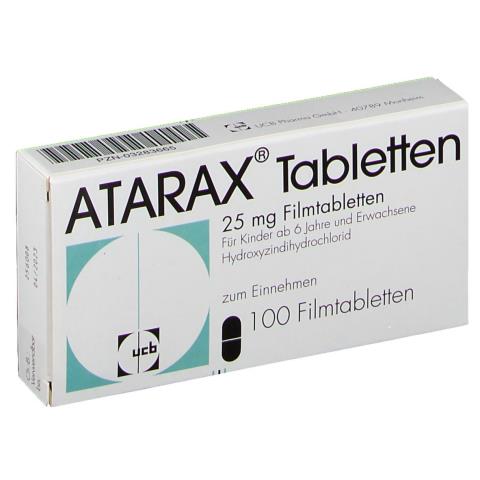Everything you need to know about Atarax (hydroxyzine hydrochloride)

What is Atarax (hydroxyzine hydrochloride)? How to use the drug to achieve the effect? What should be kept in mind when taking the drug? Let's analyze the article with SignsSymptomsList below to understand deeply about Atarax (hydroxyzine hydrochloride) drug!
Active ingredient: hydroxyzine hydrochloride.
Similar ingredient names: Atarax; Philhydarax tab.
content
- 1. What is Atarax (hydroxyzine hydrochloride)?
- 2. In case of not taking Atarax
- 3. Instructions for taking Atarax (hydroxyzine hydrochloride)
- 4. Atarax side effects
- 5. Drug interactions with Atarax (hydroxyzine hydrochloride)
- 6. Notes when using Atarax
- 7. For pregnant and lactating women
- 8. Treatment of drug overdose Atarax
- 9. Dealing with missed doses of Atarax
- 10. How to store medicine
1. What is Atarax (hydroxyzine hydrochloride)?
Atarax is a brand name drug that contains the active ingredient hydroxyzine hydrochloride. The drug is indicated in the following cases:
- Prevent vomiting
- Anti-itch (allergic)
- Anxiety, sedative before and after surgery
- Control of agitation in acute alcohol withdrawal syndrome
2. In case of not taking Atarax

- Pregnant and lactating people.
- The drug should not be injected intravenously, arterially or under the skin.
- Hypersensitivity to hydroxyzine or any other ingredient of the preparation;
3. Instructions for taking Atarax (hydroxyzine hydrochloride)
3.1. How to use
It should be taken orally instead of intramuscularly as soon as possible. The principle should be to use the lowest dose but still effective. The drug should not be injected under the skin, artery or intravenously because it can cause serious side effects.
Intramuscular injection in adults: It is recommended to inject deep into the upper quadrant of the gluteal muscle or the lateral – mid-thigh. Inject with caution in the deltoid region and only when the muscle is well developed, to avoid damage to the radial nerve.
For children, it is recommended to inject into the mid-lateral thigh muscle. Inject only when needed (eg, in children with burns) to the outer edge of the lateral upper quadrant of the gluteal muscle, to minimize the risk of sciatic nerve damage.
3.2. Amount
Treat itchiness
- Adults and children >12 years old
+ Start taking 25 mg/time in the evening.
+ Can be increased to 25 mg / time, orally 3-4 times / day if needed. - Children
+ From 6 months to 6 years old: Take 5 - 15 mg/time in the evening, can increase to 50 mg/day, divided into 3-4 times/day.
+ From 6 to 12 years old: Take 15-25 mg/time in the evening, can increase to 50-100 mg/day, divided into 3-4 times/day.
+ Or calculated according to the child's weight as follows: Take 1 mg/kg/day, divided into several doses, increase to a maximum of 2.5 mg/kg/day for children from 1 to 6 years old or to a maximum of 2 mg /kg/day for children over 6 years old. - Elderly
+ The starting dose is lower than the lower limit of the recommended adult dose range.
+ Can take 10 mg / time, 3-4 times / day, if necessary, can increase to 25 mg / time, x 3-4 times / day.
Antiemetic (excludes nausea and vomiting caused by pregnancy)
- Intramuscular injection 25-100 mg/time for adults and dose 1.1 mg/kg for children.
- Next, it is necessary to adjust according to the patient's response.
Anxiety treatment
- Adults: Take 25-100 mg/time, 4 times/day.
- Children ≥ 6 years old: Take 50-100 mg/day, divided into several doses.
- Children < 6=""> Take 50 mg/day, divided into several doses.
Relieve anxiety before and after anesthesia:
- Adults: Take 50-100 mg; or 25-100 mg intramuscularly.
- Children: 0.6 mg/kg orally or 1.1 mg/kg intramuscularly.
Managing agitation caused by alcohol withdrawal:
Adults, 50-100 mg intramuscularly / time, every 6 hours, then inject again.
4. Atarax side effects

- Athritis
- Sore throat
- Mild to moderate drowsiness
- Thickens bronchial secretions
- Tremor, convulsions (rarely)
- Headache, fatigue, restlessness, dizziness
- Better appetite, weight gain, nausea, diarrhea, abdominal pain, dry mouth
- Palpitations, hypotension, edema, depression, lethargy, paradoxical excitability, insomnia, angioedema, photosensitivity, rash, urinary retention, hepatitis, myalgia, tremor, paresthesia, blurred vision, bronchospasm, nosebleed
5. Drug interactions with Atarax (hydroxyzine hydrochloride)
- Epinephrine (adrenaline)
- Droperidol, methotrimeprazine, pramlintide.
- Amphetamines, acetylcholinesterase inhibitors.
- Other anticholinergics, may potentiate the effect
- Opiates, analgesics, barbiturates, other sedatives, anesthetics or alcohol.
If a vasoconstrictor is necessary, noradrenaline or metaraminol should be used, but epinephrine should not be given to a person taking Atarax.
6. Notes when using Atarax
- Reduce dose in patients with liver and kidney failure
- Anticholinergic effects are not well tolerated in the elderly
- Extravasation that occurs can cause aseptic abscess and marked tissue stiffness
- Do not inject subcutaneously, intravenously or intravenously because thrombosis or gangrene of the toes and hands may occur
- Short-term use of antipruritic hydroxyzin, but not as a sedation in the elderly
- Caution should be exercised in subjects with narrow-angle glaucoma, prostatic hypertrophy, bladder neck obstruction, asthma or chronic obstructive pulmonary disease.
7. For pregnant and lactating women
7.1. Pregnant women
It has been reported that hydroxyzine is teratogenic in mice, rats and rabbits, when administered at doses much larger than the therapeutic human dose. There is still no evidence to prove the safety level of the drug in this subject.
7.2. Breastfeeding Women
There are insufficient data to indicate whether the drug is distributed into breast milk. Therefore, hydroxyzine should not be administered to a nursing woman.
8. Treatment of drug overdose Atarax
8.1. Symptom
When overdose of Atarax, the patient appears symptoms such as:
- Convulsion.
- Dark feeling.
- Lower blood pressure.
8.2. Treatment
To date, there is no specific treatment for an overdose of antihistamines. However, the drug can be cleared from the stomach immediately by induction of vomiting or gastric lavage. Other cases can be handled as:
- If coma, convulsions, or loss of vomiting reflex are present, gastric lavage may be performed. Note that an endotracheal tube with an inflated balloon should be inserted to prevent aspiration of gastric contents.
- In case the patient has low blood pressure, it is possible to receive intravenous fluids and use noradrenalin or metaraminol to treat.
- Although hemodialysis or peritoneal dialysis may not be effective for hydroxyzine, if another drug (barbiturates) has been used in combination, dialysis may be indicated for removal.
9. Dealing with missed doses of Atarax
- Take it as soon as you remember you have missed a dose.
- If the dose you missed is close to the next dose that you must take. Skip the missed dose and take it at your normal schedule.
- Remember not to double the dose to make up for the dose, increase the effectiveness. But doing so increases the risk of exposure to drug toxicity.
10. How to store medicine
- Keep out of reach of children and pets.
- Store the drug in a tightly closed package, protected from light, at a temperature of 15 - 30 ºC.
- Do not use drugs that have expired and should be handled carefully before releasing them into the environment.
The above article hopes to help you know how to use Atarax. Note that the drug can cause many side effects during treatment. Therefore, if there is anything abnormal, call your doctor immediately for advice and support!
Pharmacist Nguyen Ngoc Cam Tien